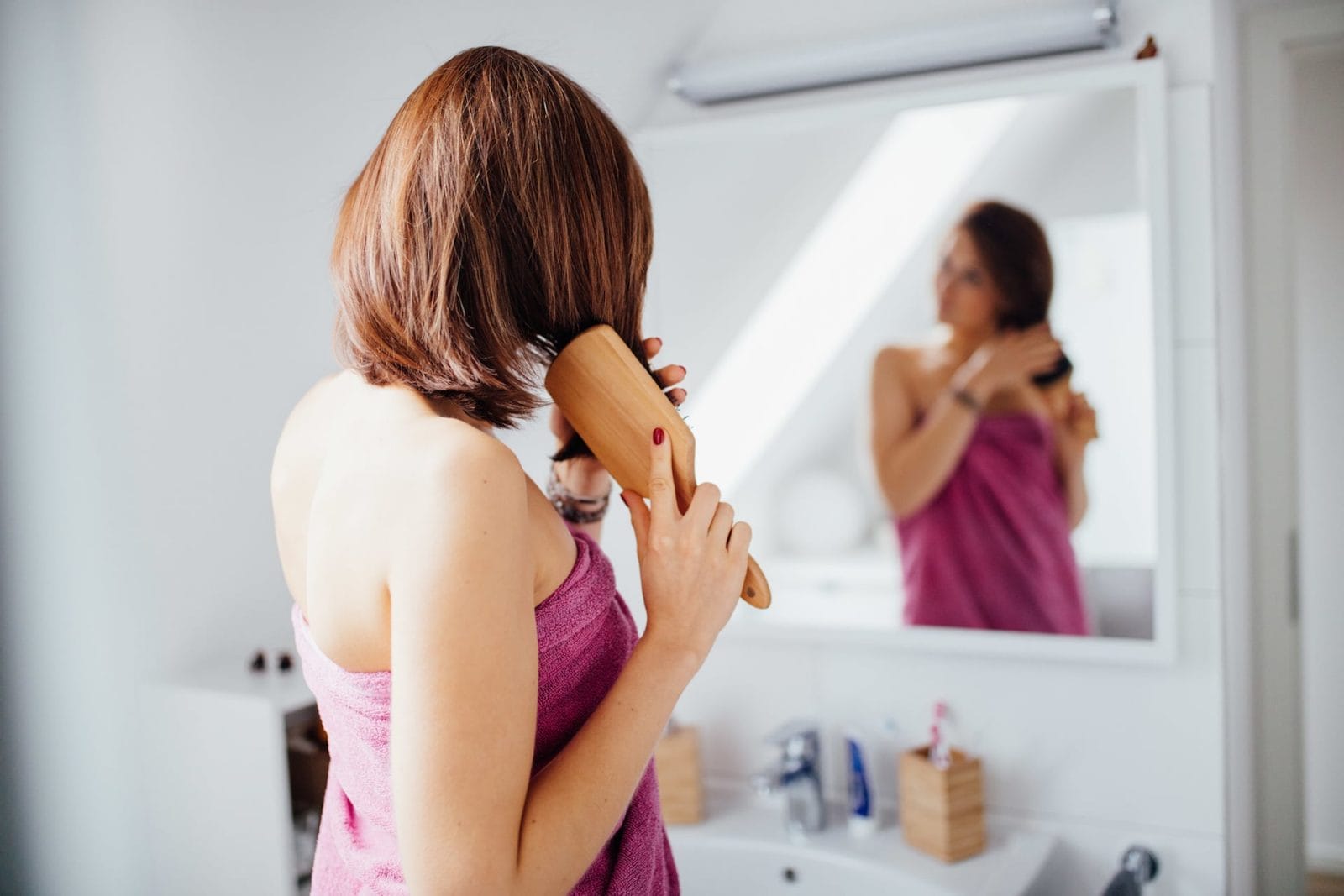7 ways to prevent postpartum hair loss, according to a scientist

@criene/Twenty20
Longer, healthier hair ahead.
Table of Contents
Among the many postpartum changes we hear and read about, postpartum hair loss is something many mamas face. If you’re among the 30% to 60% of women who are experiencing hair loss in the months following birth, you may be wondering if your strands will ever return to normal. The good news? It will—postpartum hair shedding is a temporary phenomenon.
Hair changes in pregnancy
During pregnancy, your estrogen and progesterone levels soar, particularly from the second trimester. Estrogen, in particular, has a powerful effect on multiple systems in the body, including the skin and sebaceous glands, and also on the underlying growth pattern of hair. Many women notice improvements in skin and hair quality during pregnancy and fast-growing, hydrated hair. The changes in hair can be attributed to the way estrogen impacts the specific pattern of growth unique to hair.
Our hair follicles, the small organs that produce hair, operate in a pattern of growth, rest and fall that repeats many times in your lifetime. Usually, each follicle follows its own pattern in its own time and in this manner—you are continually shedding at a rate of about 50-100 hairs a day.
During pregnancy, the excess estrogen encourages the hair to enter and stay in the growth phase, meaning it will grow faster and shed less, somewhat synchronizing the follicles in their growth.
What causes postpartum hair loss?
Following labor and birth, estrogen and other hormone levels fall rapidly to pre-pregnancy levels. In addition, cortisol levels remain high, and in some women, thyroid hormones can get out of balance. This creates a rapid synchronous transition of follicles out of their growth phase and into the resting phase. Couple this with the lack of sleep, potential nutritional stress and the demands of caring for a newborn and a perfect storm for hair loss is in place.
What is important to note is that when the follicles enter the resting phase, they begin to shed after 3 to 4 months. Scientifically, this process is known as telogen effluvium. The good news is that the fall is actually precipitated in most cases by the emergence of a new hair that has regenerated from stem cells in the scalp.
And, it is important to remember that the hair fall does not happen until 3 to 4 months after birth, so implementing strategies early can help reduce the severity of the issue.
How to prevent postpartum hair loss
1. Take care of your hair
When your follicles are in the telogen phase (the resting phase of the hair follicle), they are in their most fragile state and can be dislodged easily. To avoid premature shedding, be gentle with your hair when brushing, washing and drying, and avoid tight hair styles that place too much traction on the follicles.
A silk pillowcase can also help to make sure your hair isn’t pulled out in your sleep. Being kind to your hair will ensure your telogen hairs stay in the scalp as long as possible.
2. Maintain a healthy diet
While the hormonal changes that contribute to postpartum hair loss can be unavoidable, nutritional changes and added demands on the body’s energy after birth can also mess with the hair cycle. When the body is in nutrient imbalance, it shuttles energy to essential organ systems such as the brain, lungs, heart and liver, and away from unnecessary functions such as growing hair.
Such changes can exacerbate or extend the period of postnatal hair loss. To avoid this, make sure you eat a well-balanced diet with plenty of protein, leafy greens, fruits and vegetables.
3. Get nutritional support
It’s not always easy for a new family or growing family to prepare good balanced meals, or even eat at regular times after the arrival of a baby, To help your body get the nutrients it needs, try taking a postnatal supplement–these will supply the vitamins and minerals needed to minimize changes to your hair. Always ask the advice of your physician before starting any supplementation.
4. Minimize stress
Stress hormones such as cortisol can have a negative impact on your hair cycle, compounding the hormonal changes after birth. While it may not be easy to relax with a newborn, aim to take some relaxing time out just for you. Try meditation or indulge in a massage or spa day. Gentle exercise such as modified postnatal yoga can also help reduce stress levels.
5. Change your style
Many new moms opt for a shorter, easy-to-manage hairstyle. Not only can shorter hair be styled to hide thinner hair, but shorter hair will also help when the new hair starts to grow in. All or most of the hair that sheds will grow back, but the process takes time. New hairs will appear as fly-aways, so this hairstyle will help the newer hairs blend with the remaining hair and they can grow out together.
6. Add volume + fortify
Look for gentle, lightweight cleansers and conditioners specifically designed to volumize, preferably clean and natural, with added ingredients such as keratin for fortification and baobab to provide hydration. Protect your remaining strands and add volume by using volumizing and texturizing products. A dry shampoo can also boost volume and texture. Use sparingly and in a well-ventilated area.
7. Monitor your hair cycle
While some hair changes are inevitable for many women, there is natural technology that can help keep the hair cycle healthy. Professional activators are topically applied serums that use botanicals such as glycyrrhizin from licorice root, salicylic acid and a blend of botanicals such as sanguisorba and Japanese rose hips that act on the hair growth cycle, preventing excess hair fall and boosting growth. Topical activators can be safely used during breastfeeding and can naturally support a healthy hair cycle, while the companion volume-boosting and fortifying shampoos, conditioners and hair masks have been specifically designed to support during excess hair fall and hair thinning.
Postpartum hair loss can be a distressing experience for many new moms, but there are steps you can take to minimize its impact and promote healthy hair growth. In addition to the strategies mentioned above, it’s essential to address any underlying hormonal imbalances or nutritional deficiencies that may be contributing to hair loss. Consulting with a healthcare provider or a dermatologist can help identify any potential issues and develop a personalized plan for managing postpartum hair loss. Remember, while postpartum hair loss is a common and temporary condition, prioritizing self-care and seeking support can make the transition easier for you as you adjust to life with your new baby.
Frequently Asked Questions about Postpartum Hair Loss
1. When does postpartum hair loss typically start and stop?
Postpartum hair loss usually begins around three to four months after giving birth. It can continue for several months before gradually slowing down and returning to normal levels. Most women notice significant improvement in their hair density and volume by around six to twelve months postpartum.
2. How much hair loss is considered normal after giving birth?
It’s normal to experience increased hair shedding after childbirth, with some women noticing clumps of hair falling out while washing or brushing their hair. Typically, this shedding does not result in noticeable thinning or bald spots and is temporary. However, if you’re concerned about the extent of your hair loss or if you’re experiencing other symptoms along with it, it’s a good idea to consult with a healthcare provider or dermatologist for further evaluation.
3. Are there any ways to prevent or minimize postpartum hair loss?
While postpartum hair loss is a natural and temporary process for many women, there are steps you can take to support healthy hair growth and minimize excessive shedding. These include maintaining a balanced diet rich in essential nutrients, practicing stress-reducing techniques such as meditation or yoga, using gentle hair care products, and avoiding hairstyles that pull on the hair follicles. Additionally, some women find that taking postnatal supplements or using topical hair growth treatments can help promote hair regrowth and improve overall hair health.
4. Is postpartum hair loss the same as postpartum alopecia?
Postpartum hair loss refers to the temporary increase in hair shedding that many women experience after giving birth, typically due to hormonal changes. Postpartum alopecia, on the other hand, refers to a more severe form of hair loss that can result in noticeable thinning or bald patches and may require medical intervention. While postpartum hair loss is common and usually resolves on its own, postpartum alopecia is less common and may require treatment from a dermatologist or healthcare provider.
5. Can breastfeeding contribute to postpartum hair loss?
Some women may notice increased hair shedding while breastfeeding, as hormonal changes associated with lactation can affect the hair growth cycle. However, breastfeeding itself is not a direct cause of postpartum hair loss. It’s essential to maintain a nutritious diet and overall healthy lifestyle while breastfeeding to support both your own health and the health of your baby.
6. How long does it take for hair to grow back after postpartum hair loss?
Hair typically begins to regrow within a few months after postpartum hair loss peaks. However, the regrowth process can vary from person to person, and it may take several months for new hair to become noticeable. In some cases, it may take up to a year or longer for hair to fully regrow to its pre-pregnancy thickness and density. If you’re concerned about the rate of hair regrowth or experiencing any unusual symptoms, it’s best to consult with a healthcare provider for personalized guidance.
A version of this post was originally published on Aug. 29, 2019. It has been updated.





































